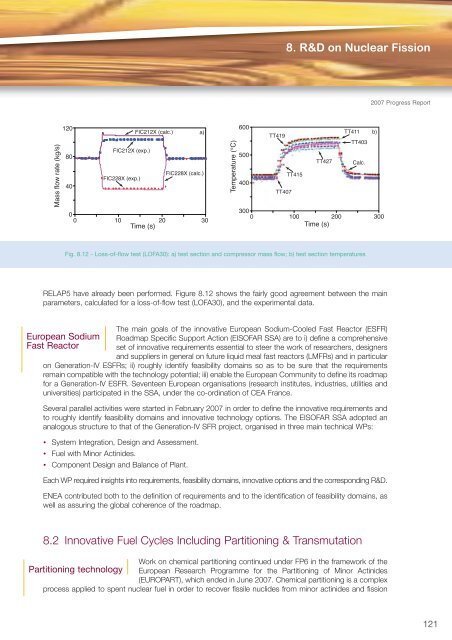Fusion Programme - ENEA - Fusione
Fusion Programme - ENEA - Fusione
Fusion Programme - ENEA - Fusione
- No tags were found...
Create successful ePaper yourself
Turn your PDF publications into a flip-book with our unique Google optimized e-Paper software.
8. R&D on Nuclear Fission2007 Progress ReportMass flow rate (kg/s)12080400FIC212X (exp.)FIC228X (exp.)FIC212X (calc.) a)FIC228X (calc.)0 10 20 30Time (s)Temperature (°C)600TT419TT411TT403b)500TT427 Calc.TT415400TT4073000 100200 300Time (s)Fig. 8.12 - Loss-of-flow test (LOFA30): a) test section and compressor mass flow; b) test section temperaturesRELAP5 have already been performed. Figure 8.12 shows the fairly good agreement between the mainparameters, calculated for a loss-of-flow test (LOFA30), and the experimental data.The main goals of the innovative European Sodium-Cooled Fast Reactor (ESFR)European Sodium Roadmap Specific Support Action (EISOFAR SSA) are to i) define a comprehensiveFast Reactor set of innovative requirements essential to steer the work of researchers, designersand suppliers in general on future liquid meal fast reactors (LMFRs) and in particularon Generation-IV ESFRs; ii) roughly identify feasibility domains so as to be sure that the requirementsremain compatible with the technology potential; iii) enable the European Community to define its roadmapfor a Generation-IV ESFR. Seventeen European organisations (research institutes, industries, utilities anduniversities) participated in the SSA, under the co-ordination of CEA France.Several parallel activities were started in February 2007 in order to define the innovative requirements andto roughly identify feasibility domains and innovative technology options. The EISOFAR SSA adopted ananalogous structure to that of the Generation-IV SFR project, organised in three main technical WPs:• System Integration, Design and Assessment.• Fuel with Minor Actinides.• Component Design and Balance of Plant.Each WP required insights into requirements, feasibility domains, innovative options and the corresponding R&D.<strong>ENEA</strong> contributed both to the definition of requirements and to the identification of feasibility domains, aswell as assuring the global coherence of the roadmap.8.2 Innovative Fuel Cycles Including Partitioning & TransmutationWork on chemical partitioning continued under FP6 in the framework of thePartitioning technology European Research <strong>Programme</strong> for the Partitioning of Minor Actinides(EUROPART), which ended in June 2007. Chemical partitioning is a complexprocess applied to spent nuclear fuel in order to recover fissile nuclides from minor actinides and fission121













